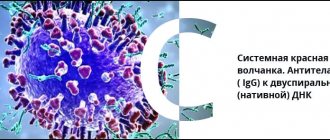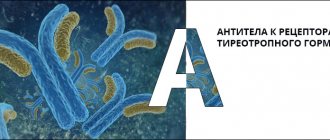Antibodies to nuclear antigens, ANA
Antibodies to nuclear antigens, ANA (antinuclear antibodies, antinuclear factor)
- a marker of autoimmune connective tissue diseases.
Detection of ANA is used in diagnosis, assessment of activity and control of treatment of connective tissue pathology. Antibodies to nuclear antigens
are a group of autoantibodies that bind to nucleic acids and their associated proteins in the cell nucleus.
ANAs are detected in the blood of patients with a variety of autoimmune diseases, such as systemic connective tissue diseases, autoimmune pancreatitis and primary biliary cirrhosis, as well as some malignancies. The determination of ANA is important for assessing the monitoring of the course of juvenile chronic arthritis in combination with juveitis and secondary Raynaud's phenomenon associated with systemic rheumatic diseases.
The ANA study is used as a screening for autoimmune diseases in a patient with clinical signs of an autoimmune process (prolonged fever of unknown origin, articular syndrome, skin rashes, weakness, etc.).
For patients with positive test results, confirmatory tests are recommended using more specific ANAs for individual nuclear and cytoplasmic antigens (dsDNA, Sm, SS-A/Ro, SS-B/La, Scl-70, RNP). It should be noted that a negative ANA test result does not exclude the presence of an autoimmune disease.
Indications:
- for screening autoimmune diseases, such as systemic connective tissue diseases, autoimmune hepatitis, primary biliary cirrhosis, etc.;
- for diagnosing systemic lupus erythematosus, assessing its activity, making a prognosis and monitoring its treatment;
- for the diagnosis of drug-induced lupus.
Preparation
It is recommended to donate blood in the morning, between 8 am and 12 pm. Blood is taken on an empty stomach or 4–6 hours after the last meal. It is allowed to drink water without gas and sugar. On the eve of the examination, food overload should be avoided.
Interpretation of results
Reference values: positivity index (PI), less than 1.0 - not detected.
Increasing values:
- systemic lupus erythematosus;
- drug-induced lupus;
- mixed connective tissue disease;
- Sjögren's syndrome;
- scleroderma;
- CREST syndrome;
- polymyositis, dermatomyositis;
- rheumatoid arthritis.
Antibodies to nuclear antigens (ANA), screening
Antibodies to nuclear antigens (ANA) are a heterogeneous group of autoantibodies directed against components of the body's own nuclei. They are a marker of autoimmune diseases and are determined for their diagnosis, assessment of activity and monitoring of their treatment.
Synonyms Russian
Antinuclear antibodies, antinuclear antibodies, antinuclear factor, ANF.
English synonyms
Antinuclear Antibody, ANA, Fluorescent Antinuclear Antibody, FANA, Antinuclear factor, ANF.
Research method
Enzyme-linked immunosorbent assay (ELISA).
What biomaterial can be used for research?
Venous blood.
How to properly prepare for research?
Do not smoke for 30 minutes before donating blood.
General information about the study
Antibodies to nuclear antigens (ANA) are a heterogeneous group of autoantibodies directed against components of the body's own nuclei. They are detected in the blood of patients with a variety of autoimmune diseases, such as systemic connective tissue diseases, autoimmune pancreatitis and primary biliary cirrhosis, as well as some malignancies. The ANA study is used as a screening for autoimmune diseases in a patient with clinical signs of an autoimmune process (prolonged fever of unknown origin, articular syndrome, skin rashes, weakness, etc.). Such patients, if the test result is positive, require further laboratory evaluation, including tests more specific for each autoimmune disease (for example, anti-Scl-70 for suspected systemic scleroderma, anti-mitochondrial antibodies for suspected primary biliary cirrhosis). It should be noted that a negative ANA test result does not exclude the presence of an autoimmune disease.
ANAs are most common in patients with systemic lupus erythematosus (SLE). They are found in 98% of patients with it, which allows us to consider this study as the main test for diagnosing SLE. The high sensitivity of ANA for SLE means that repeated negative results make the diagnosis of SLE questionable. However, the absence of ANA does not completely exclude the disease. In a small proportion of patients, ANAs are absent at the onset of SLE symptoms but occur during the first year of the disease. In 2% of patients, antibodies to nuclear antigens are never detected. If the test result is negative in a patient with symptoms of SLE, it is advisable to perform more SLE-specific laboratory tests, primarily anti-double-stranded DNA antibodies (anti-dsDNA). Detection of anti-dsDNA in a patient with clinical signs of SLE is interpreted in favor of the diagnosis of SLE, even in the absence of ANA.
SLE occurs as a result of a complex of immunological disorders that develop over a long period of time. The degree of imbalance of the immune system gradually increases over the course of the disease, which is reflected in an increase in the spectrum of autoantibodies. The first stage of the autoimmune process is characterized by the presence of genetic features of the immune response (for example, certain major histocompatibility complex, HLA alleles) in the absence of laboratory testing abnormalities. At the second stage, autoantibodies can be detected in the blood, but there are no clinical signs of SLE. Antibodies to nuclear antigens, as well as anti-Ro-, anti-La-, antiphospholipid antibodies are most often detected at this stage. Detection of ANA is associated with a 40-fold increase in the risk of SLE. The period between the onset of ANA and the development of clinical symptoms varies, averaging 3.3 years. Patients with a positive ANA test result are at risk for developing SLE and require periodic follow-up with a rheumatologist and laboratory testing. The third stage of the autoimmune process is characterized by the appearance of symptoms of the disease, while the widest range of autoantibodies can be detected in the blood, including anti-Sm antibodies, antibodies to double-stranded DNA and ribonucleoprotein. Thus, to obtain complete information about the degree of immunological disorders in SLE, the ANA test must be supplemented with an analysis for other autoantibodies.
The course of SLE varies from persistent remission to fulminant lupus nephritis. To predict the disease, assess its activity and the effectiveness of treatment, various clinical and laboratory criteria are used. Since none of the tests can clearly predict exacerbation or damage to internal organs, monitoring of SLE is always a comprehensive assessment, including the study of ANA, as well as other autoantibodies and some general clinical indicators. In practice, the doctor independently determines a set of tests that most accurately reflect how the course of the disease changes in each patient.
Drug-induced lupus represents a special clinical syndrome. It develops while taking certain medications (most often procainamide, hydralazine, some ACE inhibitors and beta blockers, isoniazid, minocycline, sulfasalazine, hydrochlorothiazide, etc.) and is characterized by symptoms reminiscent of SLE. ANA can also be detected in the blood of most patients with drug-induced lupus. If there are symptoms of an autoimmune process in a patient taking these drugs, an ANA test is recommended to rule out drug-induced lupus. The peculiarity of drug-induced lupus is the disappearance of immunological disorders and symptoms of the disease after complete discontinuation of the drug - at this time, a control ANA study is recommended, and a negative result confirms the diagnosis of drug-induced lupus.
ANAs are detected in 3-5% of healthy people (in the group of patients over 65 years of age, this figure can reach 10-37%). A positive result in a patient without symptoms of an autoimmune process must be interpreted taking into account additional anamnestic, clinical and laboratory data.
What is the research used for?
- For screening autoimmune diseases such as systemic connective tissue diseases, autoimmune hepatitis, primary biliary cirrhosis, etc.
- For diagnosing systemic lupus erythematosus, assessing its activity, making a prognosis and monitoring its treatment.
- For the diagnosis of drug-induced lupus.
When is the study scheduled?
- For symptoms of an autoimmune process: prolonged fever of unknown origin, joint pain, skin rash, unmotivated fatigue, etc.
- For symptoms of systemic lupus erythematosus (fever, skin lesions), arthralgia/arthritis, pneumonitis, pericarditis, epilepsy, kidney damage.
- Every 6 months or more frequently when evaluating a patient diagnosed with SLE.
- When prescribing procainamide, disopyramide, propafenone, hydralazine and other drugs associated with the development of drug-induced lupus.
What do the results mean?
Reference values: negative.
Reasons for the positive result:
- systemic lupus erythematosus;
- autoimmune pancreatitis;
- autoimmune thyroid diseases;
- malignant neoplasms of the liver and lungs;
- polymyositis/dermatomyositis;
- autoimmune hepatitis;
- mixed connective tissue disease;
- myasthenia gravis;
- diffuse interstitial fibrosis;
- Raynaud's syndrome;
- rheumatoid arthritis;
- systemic scleroderma;
- Sjögren's syndrome;
- taking medications such as procainamide, disopyramide, propafenone, some ACE inhibitors, beta blockers, hydralazine, propylthiouracil, chlorpromazine, lithium, carbamazepine, phenytoin, isoniazid, minocycline, hydrochlorothiazide, lovastatin, simvastatin.
Reasons for negative results:
- norm;
- incorrect collection of biomaterial for research.
What can influence the result?
- Uremia may lead to a false negative result.
- Many drugs are associated with the development of drug-induced lupus and the appearance of ANA in the blood.
Important Notes
- A negative result in a patient with signs of an autoimmune process does not exclude the presence of an autoimmune disease.
- ANAs are detected in 3-5% of healthy people (10-37% over the age of 65 years).
- A positive result in a patient without symptoms of an autoimmune process must be interpreted taking into account additional anamnestic, clinical and laboratory data (the risk of SLE in such patients is increased 40 times).
Also recommended
- Complete blood count (without leukocyte formula and ESR)
- Leukocyte formula
- General urine analysis with sediment microscopy
- Serum creatinine
- Serum albumin
- Complement component C3
- Alanine aminotransferase (ALT)
- Aspartate aminotransferase (AST)
- Total bilirubin
- Screening for connective tissue diseases
- Antibodies to extractable nuclear antigen (ENA screen)
- Antinuclear antibodies (anti-Sm, RNP, SS-A, SS-B, Scl-70, PM-Scl, PCNA, CENT-B, Jo-1, histones, nucleosomes, Ribo P, AMA-M2), immunoblot
- Anti-double-stranded DNA (anti-dsDNA) screening
- Diagnosis of systemic lupus erythematosus
- Antiphospholipid IgG antibodies
- Antiphospholipid antibodies IgM
- Diagnosis of antiphospholipid syndrome (APS)
Who orders the study?
Rheumatologist, dermatovenerologist, nephrologist, pediatrician, general practitioner.
Literature
- Arbuckle MR, McClain MT, Rubertone MV, Scofield RH, Dennis GJ, James JA, Harley JB. Development of autoantibodies before the clinical onset of systemic lupus erythematosus. N Engl J Med. 2003 Oct 16;349(16):1526-33.
- Bizzaro N, Tozzoli R, Shoenfeld Y. Are we at a stage to predict autoimmune rheumatic diseases? Arthritis Rheum. 2007 Jun;56(6):1736-44.
- Guidelines for referral and management of systemic lupus erythematosus in adults. American College of Rheumatology Ad Hoc Committee on Systemic Lupus Erythematosus Guidelines. Arthritis Rheum. 1999 Sep;42(9):1785-96.
- Fauci et al. Harrison's Principles of Internal Medicine/A. Fauci, D. Kasper, D. Longo, E. Braunwald, S. Hauser, J. L. Jameson, J. Loscalzo; 17 ed. – The McGraw-Hill Companies, 2008.
Antinuclear antibodies, screening (ANA-Screen)
The ANA-Screen ELISA (IgG) test is intended for the semi-quantitative in vitro determination of human IgG autoimmune antibodies to ten different antigens: dsDNA, histones, ribosomal P proteins, nRNP, Sm, SS-A, SS-B, Scl-70, Jo -1 and centromeres in serum and plasma.
One of the most common screening tests used in the diagnosis of systemic connective tissue lesions.
This is a qualitative determination of IgG autoantibodies to extractable nuclear antigens (a heterogeneous group of proteins and nucleic acids of the cell nucleus). The detection of these antibodies is highly likely to indicate active lupus erythematosus (sensitivity 98%), they can also be observed in other systemic rheumatic diseases.
Determination of antibodies to nuclear antigens is of great importance for the diagnosis of collagenosis. With periarteritis nodosa, the titer can increase to 1:100, with dermatomyositis - 1:500, with systemic lupus erythematosus - 1:1000 and higher. In SLE, a test for detecting antinuclear factor has a high degree of sensitivity (89%), but moderate specificity (78%) compared to a test for detecting antibodies to native DNA (sensitivity 38%), specificity 98%). There is no correlation between the titer height and the patient’s clinical condition, however, the detection of antibodies to nuclear antigens serves as a diagnostic criterion and has important pathogenetic significance. Antibodies to nuclear antigens are highly specific for systemic lupus erythematosus. Maintaining a high level of antibodies for a long time is an unfavorable sign. A decrease in level predicts remission or (sometimes) death.
In scleroderma, the frequency of detection of antibodies to nuclear antigens is 60-80%, but their titer is lower than SLE. There is no relationship between the level of antinuclear factor in the blood and the severity of the disease. In rheumatoid arthritis, SLE-like forms of the course are often identified, so antibodies to nuclear antigens are often detected. With dermatomyositis, antibodies to nuclear antigens are found in the blood in 20-60% of cases (titer 1:500), with periarteritis nodosa - in 17% (1:100), with Sjögren's disease - in 56% in combination with arthritis and in 88% cases – in combination with Gougerot-Sjögren syndrome. In discoid lupus erythematosus, antinuclear factor is detected in 50% of patients.
In addition to rheumatic diseases, antibodies to nuclear antigens in the blood are detected in chronic active hepatitis (30-50% of cases).
Autoantibodies to nuclear antigens can be detected in the blood in infectious mononucleosis, acute and chronic leukemia, acquired hemolytic anemia, Waldenström's disease, liver cirrhosis, biliary cirrhosis, hepatitis, malaria, leprosy, chronic renal failure, thrombocytopenia, lymphoproliferative diseases, myasthenia gravis and thymomas.
In almost 10% of cases, antinuclear factor is detected in healthy people, but their titer does not exceed 1:50.
IgG antinuclear antibodies (S-ANA IgG)
Antinuclear IgG antibodies
(antinuclear antibodies) are autoantibodies directed against their own antigens in the nucleus and cytoplasm of cells. Determination of ANA in blood serum is an important screening method for the diagnosis of systemic connective tissue diseases, autoimmune hepatitis, as well as several organ-specific autoimmune diseases. The detection of autoantibodies has important diagnostic and prognostic significance; they will allow the doctor to assess both the activity of the disease and the effectiveness of its treatment. A negative result indicates the absence of an autoimmune disease, including systemic connective tissue disease.
Indications:
The prevalence of antinuclear antibodies in the case of various autoimmune diseases is as follows:
- systemic lupus erythematosus 95-100%
- drug-induced lupus 100%
- mixed connective tissue disease (MCTD, Sharp's syndrome) 100%
- rheumatoid arthritis 20-40%
- progressive systemic sclerosis 85-95%
- polymyositis and dermatomyositis 30-50%
- Sjögren's syndrome 70-80%
- autoimmune hepatitis 30-40%
- ulcerative colitis 26%
- systemic scleroderma limited to the skin – CREST syndrome 55%
- primary biliary cirrhosis (PBC) 95-100%
Analysis method:
indirect immunofluorescence reaction (inRIF)
Reference value:
titer <1:100 negative
Interpretation:
Determination of ANA using nRIF using the HEp-2 cell line and rat/monkey liver tissue and other slides as a substrate makes it possible to determine about 40-100 different autoantibodies, which, when visually assessed under a microscope, give different types of luminescence. In case of a positive result, it should be taken into account that ANA may be present in healthy people, but an autoimmune disease does not always develop. At the same time, detected autoantibodies can precede the clinical manifestation of the disease by 10-20 years (for example, SLE, PBC).
In the healthy population, approximately 5% of young adults are ANA-positive (of which 5-10% are pregnant women), and the presence of ANA increases with age—over the age of 65, an ANA test is positive in approximately 20-30% of cases. Antinuclear antibodies can also be detected in the acute phase of various infectious diseases, during cancer, etc.
If ANA IgG is detected during screening using the nRIF method, a more accurate determination of antigens is necessary for the differential diagnosis of connective tissue disease using additional studies: determination of antibodies SS-A, SS-B, Scl-70, U1-nRNP, Sm, Jo-1, Centr from the ENA panel, or antinuclear antibody typing using the S-ANA Typ panel (nRNP/Sm, Sm, SS-A, Ro-52, SS-B, Scl-70, Jo-1, PM-Scl, CENP, dsDNA , nucleosomes, histones, ribosomal p-protein, AMA-M2) by immunoblotting. In the case of homogeneous luminescence, dsDNA IgG (a specific marker for SLE) should be determined.
In the most common systemic diseases of connective tissue, positive results are obtained by tests for determining antibodies to the following antigens and the corresponding type of luminescence using the nRIF method
| Antigen in the nucleus, cytoplasm | MFA drawing | Association with disease |
| dsDNA | Homogeneous | SLE |
| ssDNA | Homogeneous | SKV, RA |
| Histones | Homogeneous | Drug-induced lupus |
| Nucleosomes | Homogeneous | SLE |
| U1-nRNP | Coarse speckled | NWST, SKV |
| Sm | Coarse speckled | SLE |
| SSA (Ro) | Fine speckled | Sjögren's syndrome, SLE, autoimmune hepatitis |
| SSB (La) | Fine speckled | Sjögren's syndrome, SLE |
| U3-nRNP/fibrillarin | Nucleolar (nucleolar) granular | Systemic scleroderma (diffuse form), dermato/polymyositis |
| RNA polymerase I, III | Nucleolar (nucleolar) granular | Systemic scleroderma, (diffuse form) |
| PM-Scl (PM1) | Nucleolar (nucleolar) homogeneous | Dermatomyositis, polymyositis |
| Centromeres (CENP-A, B, C) | Typical fine granular (centromeric) glow | cutaneous limited systemic scleroderma (CREST syndrome) |
| DNA topoisomerase I (Scl-70) | Nucleolar (nucleolar) | Systemic scleroderma (diffuse form) |
| Ribosomal P protein | Ribosomal | SLE |
| Cycline (PCNA) | Fine speckled | SLE |
| Histidyl-tRNA synthetase (Jo-1) | Fine speckled | dermatomyositis |
| p-80-coilin | Dots in the nucleus (few nuclear dots) | SKV, PBC |
| Pyruvate dehydrogenase E2 | Typical granular fluorescence in the AMA cytoplasm | PBC |




